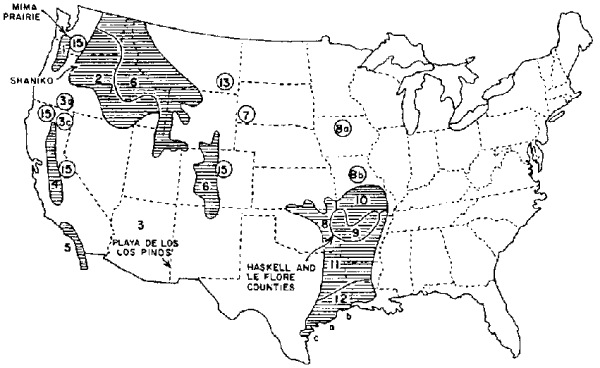 |
Science Frontiers ONLINE No. 119: Sep-Oct 1998 |
|
|
Mounds Of Mystery
Unlike many controversies in science, the debates over the origin of the Mima Mounds have been friendly. No one gets overly passionate over bizarre heaps of earth; the Mima Mounds are "fun phenomena." Nevertheless, the biggest of them on the Mima Prairie, near Little Rock, Washington, are very impressive. They are closely-packed, some 6-8 feet high and about 30 feet across. It's kind of eerie walking among them; but they are also fun to ride over in vehicles -- they create a sort of natural roller-coaster effect.
There are thousands upon thousands of mounds on the Mima Prairie. Before farmers began leveling them, they stretched for more than 20 miles. If, as some have estimated, they are about 6,000 years old, they were originally twice as high before the elements wore them down. The big question is and always has been: How were these large heaps of churned-up sand, fine gravel, and decayed vegetable matter formed?
One has to smile at the dominant theory: pocket! Sure! pocket gophers are bundles of digging energy, but each Mima Mound contains about 100 tons of soil. Multiply that figure by the thousands of mounds, and you begin to wonder about the gopher theory. Also counting against the gophers is the fact that no one has ever found gophers in the mounds, nor has a single gopher bone been found.
Now Mima Mounds are found in great numbers in many other locations in North America. South America and Africa also have their "pimpled plains" as the early geologists called them. A. Berg has pointed out that Mima Mounds tend to be concentrated in seismically active areas, whereas pocket gophers and their kindred rodent excavators have a more general distribution. This observation has led Berg to theorize that earthquake vibrations rather than gophers raised the Mima Mounds. Indeed, if you sprinkle sand on a vibrating surface in the lab, you do see tiny mounds of sand rising mysteriously. (SF#69, SF#91, SF#108) Working against Berg's theory is the rather poor geographical match between the fields of Mima Mounds and areas of high seismicity.
(Geiger, Beth; "Heaps of Confusion," Earth, 7:35, August 1998.)
Comments. Some thirty theories have been advanced to explain the Mima Mounds from ancient fish nests to the flooding due to giant tsunamis raised by asteroid impacts at sea.
 | Distribution of mima mounds and pimpled plains in the United States. The Mima Prairie is situated in Area #1. |